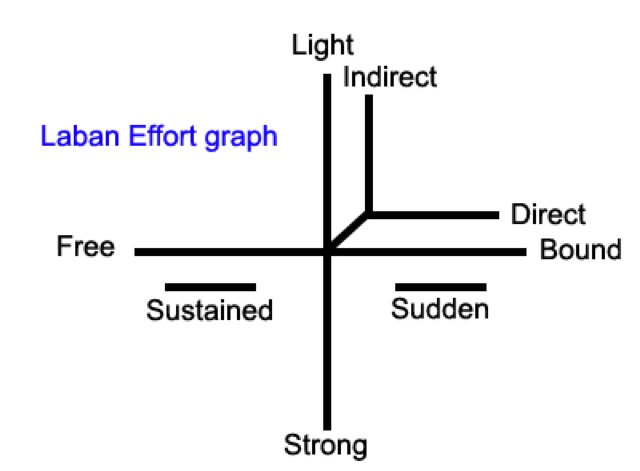Had our first class in Laban Friday afternoon with Darrell Aldridge. He began the class by talking a bit about his background, and about the background and history of Laban. Darrell is a very passionate teacher, who began with a degree in dance but then moved further into movement theory and personality analysis. After just a few minutes, we got on our feet, and Darrell took us through a devolution to get us from walking human beings all the way to jellyfish. From here, we slowly worked through a physical evoluation from jellyfish to fish, quadropeds, apes, and then humans, focusing on the specific movements of the spine and 6 limbs (arms, legs, head, tail) through these. This was paralleled with the physical development of a baby. Quickly I learned that despite having never specifically studied Laban, I had encountered these concepts through other teachers in dance years ago.
We then learned one of Laban's physical scales. The scales are structured in a similar way to a centre floor adagio, but with the intention to move the body in oppositions, opening and then closing from the navel in all directions. I really enjoyed this connection of movement.
Next we moved into the efforts of movement within the 3 dimensional cube, exploring how to exaggerate movement as light, sustained and indirect (float) or strong, direct and sudden (thrust). Homework is to complete the cube, filling in the remaining combinations of movement quality through space, time and weight.
After this, we attended a performance from some NYU students on exchange to RADA to study the arts of Shakespeare. These young american students had been studying the music, dance, combat and clown of Shakespeare's time, and performed about 1.5 hrs worth of sonnets, scenes and song/dance. What I found interesting to watch was the clarity between those performers who really understood and felt comfortable in the language compared to those who didn't. When the performer really understood the language of the sonnet or scene, the immediately relaxed, had better vocal quality and a more confident physicality. By contrast, when the actor didn't connect with the text they were wooden and awkward, and tended to poor vocal habits (bad diction, poor connection with breath).
We then learned one of Laban's physical scales. The scales are structured in a similar way to a centre floor adagio, but with the intention to move the body in oppositions, opening and then closing from the navel in all directions. I really enjoyed this connection of movement.
Next we moved into the efforts of movement within the 3 dimensional cube, exploring how to exaggerate movement as light, sustained and indirect (float) or strong, direct and sudden (thrust). Homework is to complete the cube, filling in the remaining combinations of movement quality through space, time and weight.
After this, we attended a performance from some NYU students on exchange to RADA to study the arts of Shakespeare. These young american students had been studying the music, dance, combat and clown of Shakespeare's time, and performed about 1.5 hrs worth of sonnets, scenes and song/dance. What I found interesting to watch was the clarity between those performers who really understood and felt comfortable in the language compared to those who didn't. When the performer really understood the language of the sonnet or scene, the immediately relaxed, had better vocal quality and a more confident physicality. By contrast, when the actor didn't connect with the text they were wooden and awkward, and tended to poor vocal habits (bad diction, poor connection with breath).
